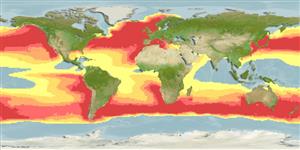Classification / Names
Common names from other countries
Main reference
आकार / वज़न / Age
Max length : 1,520 cm TL पुल्लिंग / अलिंग; (Ref. 247); 980.0 cm TL (female); common length : 700 cm TL पुल्लिंग / अलिंग; (Ref. 6077); अधिकतम प्रकाशित वज़न: 4.0 t (Ref. 4645)
Length at first maturity
Lm ?, range 500 - 980 cm
पर्यावरण
; समुद्री; औशिनोड़िरोमस (Ref. 51243); गहराई सीमा 0 - 2000 m (Ref. 26346), usually 0 - ? m (Ref. 55197)
जलवायु / सीमा
Temperate; 6°C - 24°C (Ref. 88171), preferred 17°C (Ref. 107945); 75°N - 58°S, 112°E - 42°E (Ref. 84930)
वितरण
Cosmopolitan, frequent in cold to warm temperate waters; rare in equatorial waters (Ref. 48844). Highly migratory species, Annex I of the 1982 Convention on the Law of the Sea (Ref. 26139). At risk of extinction by overfishing because of low to very low productivity (Ref. 36717). Appendix II (Mediterranean) of the Bern Convention (2002). Appendix I and II of the Bonn Convention (2009). International trade restricted (CITES Appendix II, since 28.5.2003).
देश | ऐफ ऐ ओ क्षेत्र | Ecosystems | संयोग | भूमिका
Short description
पृष्ठीय रीढ़ (सम्पूर्ण): 0; पृष्ठीय सौफट रेज़ (सम्पूर्ण): 0; गुदा कांटा 0; ऐनल सौफट रेज़: 0. Distinguished from all other sharks by the enormous gill slits practically encircling the head; dermal denticle gill rakers; pointed snout; huge, sub terminal mouth with minute hooked teeth; caudal peduncle with strong lateral keels, and lunate caudal fin. Body covered with placoid scales. Blackish to grey-brown, grey, or blue-grey, often with irregular white blotches under the head and abdomen (Ref. 43278). Also Ref. 309, 5983.
IUCN Red List Status (Ref. 115185)
Human uses
मात्स्यिकी: व्यापारिक
साधन
Special reports
Download XML
इंटरनेट स्रोत
Estimates of some properties based on models
Phylogenetic diversity index
PD50 = 1.5000 many relatives (e.g. carps) 0.5 - 2.0 few relatives (e.g. lungfishes)
Trophic Level
3.2 ±0.3 se; Based on diet studies.
लौटाव
बहुत नीचे, न्यूनतम जनसंख्या दुगनी समय अवलागत 14 महीने। (Fec=1-2; Musick et al. 2000 (Ref. 36717))
Vulnerability
Very high vulnerability (86 of 100)
Price category
